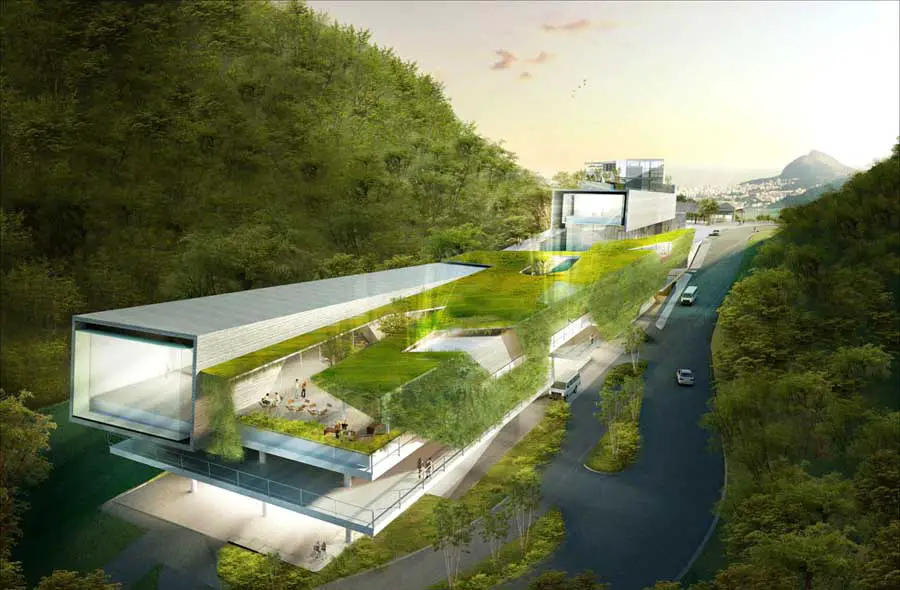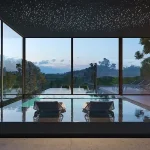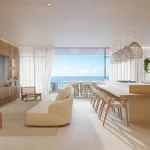Paineiras Hotel Complex, Brazil Building, Project News, Design Contest, Property Image
Paineiras Hotel Complex, Rio de Janeiro
Brazilian Competition – Honorable Mention, South America Design Contest News
Young group of architects from São Paulo, Brazil that recently received an Honorable Mention on a National Competition for the Paineiras Hotel Complex in Rio de Janeiro, Brazil a project that is due to completion in 2011 and has generated a great interest in Brazilian architecture community.
General view of the Hotel Paineiras Complex – Rio de Janeiro Design Contest:
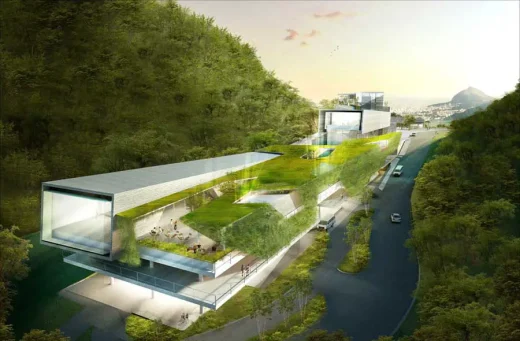
10 Nov 2009
Paineiras Hotel Building Complex
Their project was shortlisted among 148 teams from 30 different cities in Brazil.
This is their 3rd award in competitions in nearly a year.
National Competition for the Paineiras Hotel Complex – Honorable Mention
Rio de Janeiro / Brazil
Authors:
Alexandre Hepner
Denis Cossia
João Paulo Payar
Rafael Brych
Ricardo Gonçalves
Environmental design consultor:
Ricardo Messano
Hotel Paineiras Complex Competition – Description
This project received an Honorary Mention in a national competition for the Masterplanning and Architecture Design of the Hotel Paineiras Complex, in Rio de Janeiro, Brazil. It is located in the middle of the Tijuca National Park, less than a mile from the famous monument of Christ the Redeemer.
The project consists in a visitor center for the monument and the national park, an eco-tourism hotel, and a convention center. The visitor center is composed of covered public plaza, exhibition spaces, ticket booths, stores, a cafeteria, locker rooms for hikers, an open-air arena, a train station (which allows access for the monument), 250 parking spots for cars and vans, and transfer platforms.
The eco-tourism hotel was built as a retrofit of an old historic hotel that already existed in the site. The original Paineiras Hotel was built over a century ago as an isolated retreat for Rio de Janeiro’s elite, and its construction was encouraged by D. Pedro II, the last Brazilian Emperor. Along its existence the hotel received many dignitaries from other countries (especially because until the 1960’s Rio was still the Brazilian capital) and even hosted the Brazilian soccer team during the 1970’s World Cup. However, just a few years after this, the hotel entered a decadent period and was eventually abandoned, lying in a decrepit state for the last thirty years.
Concept
This project’s primary concern was its relationship with the pre-existing and surrounding environment in which it is inserted. Despite the intense visitation the Christ Redeemer monument receives, the complex still is situated right in the middle of a national park and thus cannot allow significant environmental impacts. Inversely, it should even serve as a conscience-building example for a desired relationship between man and nature.
General view of the Hotel Paineiras Complex
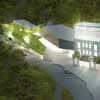
Secondly, much consideration was given to the important historic character of the original Hotel Paineiras, which in intrinsically related to the collective memory of Rio’s inhabitants and its many visitors. Although its conservation in its original state was much desired, the building on the other hand was much degraded, and also obsolete in regards to the functioning of a contemporary hotel like the one the competition promoters specified. Such situation demanded an incisive but respectful intervention.
Finally, there was also the concern of organizing the complex as an efficient support platform for tourist visitation for the park and the monument. The existing infra-structure was under-dimensioned and overwhelmed by the intense visitation, provoking great traffic jams in the access roads and providing little comfort for the visitors.
The proposed design should allow for generous spaces that could receive the foreseen numbers of tourists (which are expected to rise sharply, with the World Cup coming to Brazil in 2014 and the Olympics to Rio in 2016), but spaces that could also allow perfect fruition of the beautiful panoramic view and the close contact with nature.
Design proposal
The adopted design strategy reflects the intention of harmonizing the intervention with the existing context, thought without denying the contemporary character of such intervention nor hiding its presence among the surrounding forest and the old hotel building. Nonetheless, there prevails the concern of maintaining the general spatial configuration of the site, with the Hotel Paineiras keeping its superior hierarchic role before the rest of the complex.
The largest part of the new built volume represents the area of the tourist transfer station and related activities. Between the options of completely burying the parking levels underground (which would demand expensive land movements and high construction impact) or building them above ground (which would have a great visual impact amidst the site and the park), a third alternative was chosen, with one underground and two semi-underground levels.
This allowed the parking levels to occupy the elevation difference between the Christ Redeemer access road and the hotel, which is set upon higher ground. With this solution, the roofing of the last parking level can become an extension of the plaza in front of the hotel, significantly expanding the spaces available for the public.
This wide public plaza articulates access to all visitor activities (ticket booths, stores, cafeteria and exhibition spaces), which are organized in different independent volumes. The plaza is also covered by an angular-shaped green roof which serves three different purposes: protect the pedestrian spaces from the harsh sun and rain; visually restore the forest canopy that was put down in this stretch of the park; and reduce the environmental impact hat would be caused by the loss of the site’s permeability.
Public plaza and visitor spaces
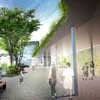
The new hotel was reconfigured with thoughtful consideration to its historic importance, but also recognizing the technical and programmatic demands of a contemporary and high standard hotel. The proposal is to completely transform the interior of the building, preserving only the front and back exterior walls and the inner pillar modulation. Between the two restored exterior walls, offset by a two-meter open space, a new hotel would be erected, with steel-framed structure and pre-cast concrete slabs.
Instead of the original floor plan functional organization (with a central corridor and rooms in both sides of the building), the new hotel will have a single corridor along the back façade and all forty rooms turned to the front façade, taking advantage of better ventilation and the astonishing panoramic scenery. The access lobby was preserved in the same original position, but now with a high covered atrium that extends to the top of the building. In the middle of this atrium, a set of six pillars from the original building were kept as a testimony of the structure that previously existed in the same place.
Outside View / Atrium View of the new Paineiras Hotel
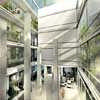
The original outer walls represent the “layer of memory” that involves the new block, an embryo of glass and light that leaks along the volume of the hotel. Externally, the reading of the new Hotel is through this historical interface, whose function goes beyond a simple testimony, since it acts as a protective grill for the rooms against the excessive sunlight and visual disturbances from the outside public, acting in a similar way as the traditional “muxarabis” from Portuguese vernacular architecture that is typical in many Brazilian colonial cities.
The new pavilion involved by the historical layer is provided with a second layer of a more contemporary aspect, composed by perforated metal sheets, which fulfill the same protective function for the top floor, which is revealed above the old walls, assuring the ethereal aspect of the new “building of light”.
This relationship between the ancient and contemporary layers reinforces the concept of symbiosis always present in the approach of the entire project, between both the buildings and the landscape.
In front of the hotel, a pre-existing porch will be kept exactly as in its original condition, and shall be maintained unobstructed, allowing the visitors to experience the fascinating views of the Christ monument and the city of Rio de Janeiro, the same way it did more than a century ago. The porch would also serve the public as an entrance to the panoramic restaurant below, a “platform of light” placed under the porch, strengthening the contemplative function of these places.
Environmental efficiency analysis / Perspective Section of the Hotel
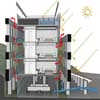
Sustainability / Environmental efficiency
Facing a landscape so significant and extremely important for the city of Rio, the insertion plan of the new complex was cautiously thought following criteria to minimize environmental and visual impact of such construction.
In the design process the main concern was to avoid large movements of earth and disturbances in the site configuration, elevating the parking floors and revealing them in a creative way, using the natural morphology of the site to accommodate them. To integrate them with the surrounding landscape, a “green layer” was designed to involve the parking floors and the public boulevard, merging the constructed mass into a powerful green pavilion that emerges from the florest. The concerning here was to develop a scenario of consistent ambience and healthy coexistence between the built and the natural landscape, not trying to deny the new intervention.
The construction process and the structure design were planned to attend the sustainability concept of the project, through the use of steel structures and non aggressive methods, streamlining the process and reducing construction waste.
The concept for the Hotel comes as a new building protected by ancient walls, which act on the thermal maintenance blocking 80% of the solar radiation focused on the western facade of the building, creating a comfort environment without sacrificing the exterior great view.
The gap between the new block and the old Hotel walls provides an airstream ventilation, preventing excessive heat to be transferred directly into the building, contributing to the eco-efficiency of the project. The air exchange inside the rooms is favored by the pressure difference on opposite sides of the Hotel.
Building Scheme ; Transfer Platforms Plans ; Hotel Plans ; Sections
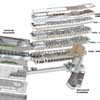
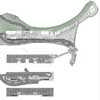
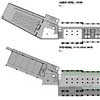
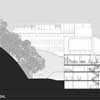
Location: Rio de Janeiro, Brazil
Brazil Architecture
American Architecture Walking Tours : city walks by e-architect
Brazil Architecture Design – chronological list
Major Recent Brazilian Architecture Competitions
Image and Audio Museum, Rio de Janeiro
Diller Scofidio + Renfro
Museu da Imagen e de Som
Itaboraí – Center for Information Comperj, Rio de Janeiro
Andrade Morettin Arquitetos
Itaborai Architecture Competition
Living Steel: 2nd International Architecture Competition for Sustainable Housing
Brazilian Architecture Competition : Recife, Pernambuco, Brazil
Major Rio de Janeiro Buildings
Cidade da Musica Roberto Marinho, Rio de Janeiro
Atelier Christian de Portzamparc
Cidade da Musica : Brazilian concert hall building
Deodoro Shooting Center, Rio de Janeiro
BCMF Arquitetos
Deodoro Shooting Center
Comments / photos for the Paineiras Hotel Complex Brazilian Architecture page welcome

